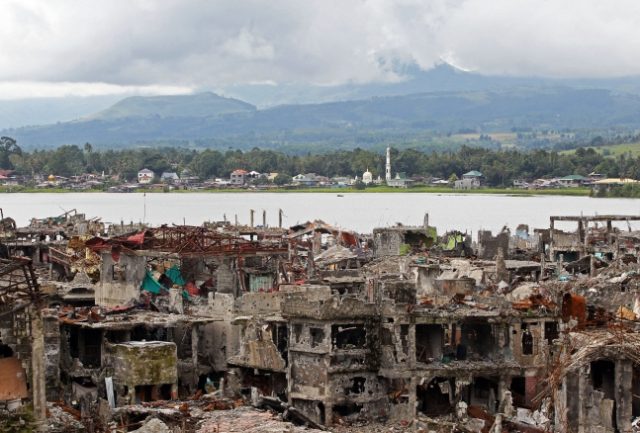
Damaged houses and buildings are seen inside the war-torn in Marawi City. KJ ROSALES / Philstar
Violent incidents related to illegal drugs grew almost six-fold in the Autonomous Region in Muslim Mindanao from 2015 to 2016, coinciding with the launch of President Rodrigo Duterte’s war on drugs when he assumed office.
But peace building organization International Alert Philippines observed: “Despite the increase in drug-related incidents, the death toll from illicit drugs was still lower than those caused by political violence … A long history of revenge-killings in the Muslim Mindanao region and the likely clan feuding that may be unleashed may have led to a more cautious approach that lessened the bloodshed in the Bangsamoro.”
International Alert Philippines launched Conflict Alert’s 2017 report titled “Guns, Drugs, and Extremism: Bangsamoro’s New Wars” on Wednesday in Taguig City.
Conflict Alert is its conflict monitoring system for Mindanao.
From 130 violent incidents related to illegal drugs in 2015, the number grew to 757 incidents in 2016. 87 percent of these incidents occurred from July to December 2016.
From four deaths in 2015, 59 were killed in drug-related incidents in 2016. As for the number of people detained or arrested, it rose from 192 in 2015 to 1,019 in 2016.
This does not mean that the shadow economy in illegal drugs was not as widespread in previous years; rather, “a hornet’s nest was stirred by the Duterte government when it launched the anti-drug campaign, turning a relatively ‘peaceful enterprise’ into a site of violent conflict,” said Conflict Alert.
While violent incidents related to the shadow economy (such as illegal drugs and illicit firearms issues) rose sharply, political issues like rebellion and extremism caused more fatalities – 428 deaths in 2016, to be exact, as compared to 203 deaths in 2015.
Violent extremism
“The ASG (Abu Sayyaf Group) accounted for many deaths (198 killed in 71 incidents in 2016), but paled in contrast to the Maute Group in terms of conflict deaths per armed confrontation (130 killed in 16 incidents in 2016),” the report said.
A new form of conflict emerged in 2016: violent extremism.
“Rebellion-related violence increased as a result of the rise in violent extremism,” added Conflict Alert. The most incidents occurred in Maguindanao, given the increasing attacks of the Bangsamoro Islamic Freedom Fighters or BIFF (63 killed in 76 incidents in 2016).
“The human costs from BIFF/BIFM (Bangsamoro Islamic Freedom Movement) activities spiraled in the first quarter in 2015 following the Mamasapano tragedy, before stabilizing towards the end of the year,” the report said.
Sulu and Basilan followed in terms of number of incidents, as they are both host to the Abu Sayyaf.
In Lanao del Sur, the Maute Group emerged that year. The three groups have pledged their allegiance to the Islamic State.
Maute
The Maute Group was the one that “really made its mark in 2016,” Conflict Alert said. Siblings Abdullah and Omarkhayam Maute “studied abroad and returned to the country completely transformed and preaching a more violent and exclusionary version of Islam”.
“Using their clan base in the town of Butig, the brothers soon mobilized their siblings, cousins, and other relatives, including some of their neighbors, to join their ragtag army of fighters … Key informants reported it was a good period for fast recruitment into the Maute Group. Job opportunities remained scarce, ethnic divisions were hardening and political tensions rising with the forthcoming 2016 elections, and a recent pyramiding scam had decimated the capital and savings of many Maranao families,” the report said.
The Maute Group went on to train its recruits, who joined for a small fee. “Education included religious training and ‘life skills’ such as the dismantling and firing of weapons and the conduct of ambush attacks,” Conflict Alert said.
“Violent extremism may overtake the magnitude of deaths associated with rebellion,” Conflict Alert stressed. “Violent extremism will require context-specific and conflict-sensitive approaches. The prominence of a security-focused response may neglect the long-term process of building community cohesion and resilience.”
Civilians, children most affected
It also pointed out that conflict in ARMM affects civilians and children the most.
“Shadow economy issues, identity issues, and common crimes were the top causes of violent conflicts affecting these two,” the report said.
Based on data from 2011 to 2016, Conflict Alert also saw a trend regarding the drivers of conflict: “Conflict typically spikes in May, before the start of classes in elementary, junior high, and senior high school, and the month associated with the holding of general and midterm elections… Conflicts dip in June before climbing in the next two months, which often coincide with the celebration of Ramadan, the holy month in the Islamic calendar, and the planting of the main season rice crop, typically the lean months.”
It warned that urban areas are increasingly becoming “theaters of violence” due to highly dense populations, the fractious nature of alliances with different groups, ideologies, and affiliations in these areas.

No comments:
Post a Comment
Note: Only a member of this blog may post a comment.